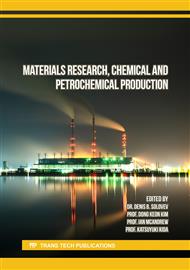[1]
N. Travitzky, A. Bonet, B. Dermeik, T. Fey, I. Filbert-Demut, L. Schlier, P. Greil, Additive manufacturing of ceramic-based materials. Advanced engineering materials, 16(2014) 729-754.
DOI: 10.1002/adem.201400097
Google Scholar
[4]
A. Evcin, Investigation of the effects of different deflocculants on the viscosity of slips, Academic Journals Scientific Research and Essays, 6(2011) 2302-2305.
Google Scholar
[6]
A. Sakar-Deliormanlı , Z. Yayla, Effect of calcium hydroxide on slip casting behavior, Applied Clay Science, 24 (2004)237–243
DOI: 10.1016/j.clay.2003.04.001
Google Scholar
[7]
A.A. Slyusar, O. A. Slyusar, N. M. Zdorenko, Complex thinning additions for ceramic slips, Glass and Ceramics, 66(2009) 297-298
DOI: 10.1007/s10717-009-9187-6
Google Scholar
[8]
E. Rastelli, A. Salomoni, A. Fregni, A. Stamenkovic, Influence of calcium phosphate on rheological properties of sanitaryware slip, Advances in Applied Ceramics,107(2013) 76-82
DOI: 10.1179/174367608x263278
Google Scholar
[9]
F. Mohammadi, O. Mirzaee, M. Tajally,Influence of solid loading on the rheological, porosity distribution, optical and the microstructural properties of YAG transparent ceramic, Ceramics International, 44 (2018) 12098–12105
DOI: 10.1016/j.ceramint.2018.03.230
Google Scholar
[10]
B. Jianga, S. Zhoua, H. Ji, B. Liao, H. Pangb, Dispersion and rheological properties of ceramic suspensions using linear polyacrylate copolymers with carboxylic groups as superplasticizer, Colloids and Surfaces A: Physicochem. Eng. Aspects 396 (2012) 310– 316
DOI: 10.1016/j.colsurfa.2012.01.015
Google Scholar
[11]
C. Guler, E. Balcir, Effect of some salts on the viscosity of slip casting, Applied Clay Science, 13 (1998) 213–218
DOI: 10.1016/s0169-1317(98)00018-0
Google Scholar
[12]
A. Papo, L. Piani, Rheological Properties of Alumina Slurries: Effect of Deflocculant Addition, Particulate Science and Technology,25(2007) 375–380
DOI: 10.1080/02726350701484014
Google Scholar
[13]
L.Piani,A.Papo, Sodium Tripolyphosphate and Polyphosphate as Dispersing Agents for Alumina Suspensions: Rheological Characterization, Journal of Engineering, 2013 (2013) 1-4
DOI: 10.1155/2013/930832
Google Scholar
[14]
H. Wang, Y. Shen, G. Fei, G. Li, Y. Zhang, Effects of Modified Poly(methacrylic acid) Copolymer on Rheological Properties of Ceramic Suspension and Sintered Ceramic Strength, Journal of Applied Polymer Science, 102 (2006) 2661–2667
DOI: 10.1002/app.24089
Google Scholar
[15]
E.V. Kotova, G. V. Mozgovoi, G. P. Kozlovskaya, M. F. Butman,Complex thinner based on soda, liquid glass and oxyethylidenediphosphonic acid in ceramic casting technology, Glass and Ceramic, 71(2014) 71-74
DOI: 10.1007/s10717-014-9620-3
Google Scholar
[16]
S. Shahrestani, M. C. Ismail, S. Kakooei, M. Beheshti, Effect of additives on slip casting rheology, microstructure and mechanical properties of Si3N4/SiC composites, Ceramics International, 46 (2020) 6182-6190
DOI: 10.1016/j.ceramint.2019.11.085
Google Scholar
[17]
M. Attariana, E. Taheri-Nassaja, P. Davamib, Effect of ethylene–vinyl acetate copolymer on the rheological behaviour of alumino-silicate/polyethylene wax suspensions, Ceramics International, 28 (2002) 507–514
DOI: 10.1016/s0272-8842(02)00003-2
Google Scholar
[18]
R. Morrell, Flexural strength testing of ceramics and hardmetals, Measurement Good Practice Guide, 7 (1997) 1386–6550.
Google Scholar
[19]
L.Hammadi, Improving of the mechanical and rheological properties of slip of ceramic, Construction and building materials, 173 (2018) 118-123.
DOI: 10.1016/j.conbuildmat.2018.04.035
Google Scholar
[20]
M. Grassi, R. Lapasin, S. Pricl, A study of the rheological behavior of scleroglucan weak gel systems. Carbohydrate Polymers, 29 (1996) 169-181.
DOI: 10.1016/0144-8617(95)00120-4
Google Scholar



